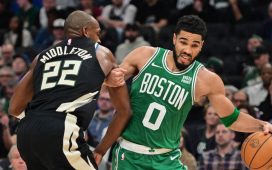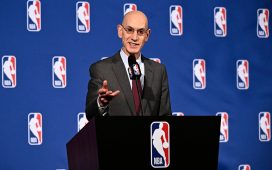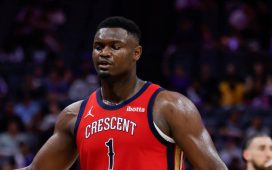For many of us, the outdoors serve as a refuge — a place to gather (at a social distance, of course) and live some sort of normalcy as the pandemic continues to disrupt society.
Then there is the artist Tyrrell Winston, who has spent years scouring the outside world to gather the material he has made integral to his work. Winston’s pieces are typically made with objects he finds outside — most commonly, flattened basketballs and cigarette butts.
“When I’m walking down the street, I’m seeing art materials,” Winston said during a recent Zoom interview. “It’s literally, ‘What can I use or what can I look at that I have never seen before?’”
Winston, 35, is based in New York City and has no formal art training, but he has made a career out of combining his two loves — basketball and art — to create compelling three-dimensional works. He said he was currently constructing something for Dan Gilbert, the owner of the Cleveland Cavaliers: a piece of 168 flattened basketballs. (Gilbert had commissioned two other pieces by Winston that are outside the Rocket Mortgage FieldHouse, where the Cavaliers play.)
Once Winston finishes this piece, it will be the largest artwork of flattened basketballs collected by an N.B.A. owner, supplanting one that belongs to Michael Rubin, a Philadelphia 76ers co-owner, who has a Winston piece made of 105 basketballs.
The flattened basketballs used to come from Winston’s travels through Manhattan and Brooklyn. A used basketball, he said, tells its own story. “And I do not have to ascribe, put words with it, and it becomes abstract in that way,” he said. “I want my work to mean many things to many people. There is no one definitive meaning.”
Now, Winston has graffiti artists sourcing balls for him in California, upstate New York, Florida, Texas and other parts of the United States. They often come from train tracks, Winston said, a common home for basketballs. Or junk shops. Estate sales. Any place. They just have to be used.
“Weather is my favorite assistant, and that’s just something I have no desire to try to figure out how to manipulate or that I want to, because the ethos of the work is about all of these touches that are not mine,” he said.
One reason Winston started using found pieces for his art was that he had $150,000 in college debt when he graduated from Wagner College with an arts administration major during the recession in 2008. He did not have money to buy materials, and on top of that, he didn’t know how to paint. But he knew he wanted to be an artist, especially after attending a Dada exhibit at the Museum of Modern Art.
Two of Winston’s biggest influences are Marcel Duchamp, the French artist who died in 1968, and David Hammons, an American artist. They pioneered “found art” pieces — although in very different ways. Duchamp was a father of Dadaism, an avant-garde art movement of the early 20th century that aimed to be “anti-art.” He dabbled in the whimsy and the outward rejection of conventional art, as in his piece “Fountain,” a urinal he signed “R. Mutt,” considered one of the most notable artworks of the 20th century. In the latter half of the 20th century, Hammons constructed several vivid commentaries on being Black in America through pieces made from hair on the floor in barbershops, from sweatshirts and from constructing basketball hoops several stories high, among many others.
Sports are a clear influence on Winston’s art, even aside from flattened basketballs and used nets — another common material for him. He grew up a Los Angeles Clippers fan in Orange County, Calif. One of his pieces, 2019’s “Don’t Forget to Floss,” has a used basketball rim on top of a stool. It is a direct homage to Duchamp, who did the same with a bicycle wheel in one of his early works. Winston’s latest exhibit is a digital display with the gallery Library Street Collective in Detroit. Sports fans will find many of the pieces familiar and possibly sacrilegious, depending on one’s point of view.
Winston, whose work has been displayed all over the world, takes on a sports-obsessed society, particularly the hype surrounding sports memorabilia. Here is a look at some of the pieces on display.
‘Punishment Paintings’
In this series of paintings, Winston recreates the signatures of some of the most famous athletes in history — painting their autographs over and over in a series called “Punishment Paintings.” Among the athletes whose autographs Winston recreates are Michael Jordan, Pete Rose, Muhammad Ali and Mickey Mantle. He suggests that their level of fame is a form of “punishment” in itself, because society does not allow them to be flawed.
“I want people to ask, ‘Why have I chosen these people?’” Winston said, adding, “We have commodified some of these athletes and we look at them as immortal and put an unfair expectation on them sometimes.”
But Winston said that the punishment of fame isn’t the only kind of punishment he is concerned with. There is also the physical.
“So when I say, ‘Punishment Paintings,’ too, it’s the training and the mental endurance that these people that we put on these pedestals have to endure,” Winston said.
‘Signing Sessions’
This is one that hard-core sports fans may find surprising. Winston simply takes pieces of valuable, authenticated, signed memorabilia — such as a Jordan-autographed basketball and a Rose-signed baseball — and puts his own John Hancock on them, a purposeful act of desecration.
The act is a homage in itself. Winston likened it to one by Robert Rauschenberg, the influential American artist who, like Duchamp, specialized in turning artistic expectations on their head. Rauschenberg once took a valuable drawing by Willem de Kooning, another 20th-century giant of American art who popularized Abstract Expressionism, and erased it with de Kooning’s permission. He put the blank piece of paper on display in 1953. Even as one of Rauschenberg’s most daring pieces, to take a valuable drawing and perform an act of what some would consider destruction, it did not create a public sensation until the 1960s.
To Winston, the signing of the Jordan ball is a tribute in itself. But he has an analogy that basketball fans today may more readily recognize as an explanation for this piece of work.
“It is Iverson crossing over Jordan his rookie year and hitting that shot,” Winston said. “I like to have those parallels. This is a moment in our history, but it’s also an athletic accomplishment. And me doing that Jordan ball, I mean, I’ll tell you, man, I was so nervous. It’s because of the respect and the admiration that I have for Michael Jordan as a basketball player. And I still think my signature looks kind of funny on it because I have so much respect.”





